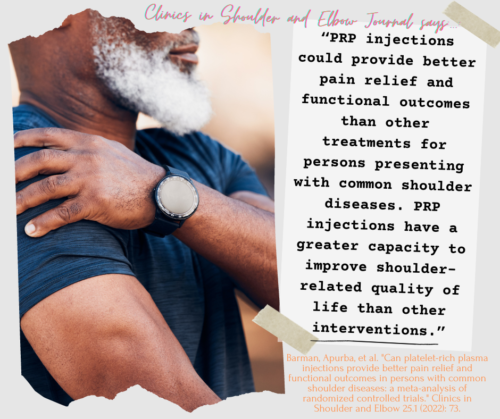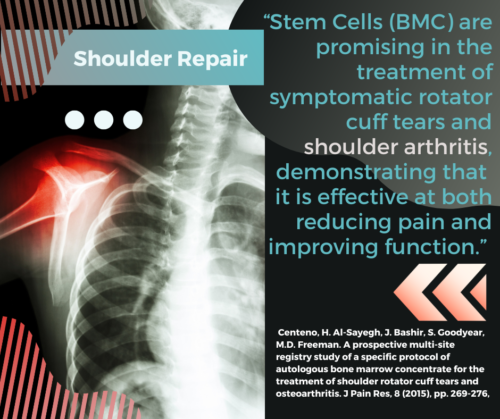
PRP Provides Pain Relief in Shoulder Diseases
Are you looking for answers to your shoulder pain? Have been told that there is a good chance shoulder surgery will not work for you? Have you already had surgery but had poorer results than expected? Or are you leaning towards a shoulder replacement because you think it is the last available treatment option?
In this article, we will discuss the options for shoulder pain and hopefully provide answers that will benefit you. Plus, we want you to know that you do have other options besides shoulder replacement. That’s a good thing because shoulder replacement does have risk as well as prolonged recovery.
So what brought you to the place of seeking shoulder repair? Very likely the underlying problem is shoulder arthritis! Shoulder arthritis can severely limit daily activities, making even getting dressed a big chore! Most people suffering with shoulder arthritis have tried a long list of treatments to find relief, like muscle relaxants, anti-inflammatories, cortisone injections, and other therapies. But it gets exhausting just managing the pain! A treatment to fix the shoulder once and for all would be so helpful, and if the treatment could be non-surgical, then that’s even better!
Shoulder arthritis is a gradual wearing of the articular cartilage accompanied by degeneration of the rotator cuff. The shoulder joint basically erodes over time, altering the shoulder structures, changing shoulder mobility, and decreasing function. The ball and shoulder socket no longer glide normally, and the rotator cuff, shoulder labrum, and shoulder tendons and ligaments become injured as they attempt to stabilize the shoulder joint. The shoulder swells in an attempt to keep the shoulder in alignment. But this constant state of inflammation erodes the joint. What is needed is treatment to stop the instability of the shoulder joint, and treatment that will rebuild and restore the soft tissue structures that have become injured and degenerated.
Regenerative Orthopedics, like Prolotherapy, PRP, and Stem Cells are treatments options that are particularly effective at repairing soft tissue of the joint and regenerating injured and degenerated joint structures. They have also been shown to be effective alternatives to surgical treatments for shoulder pain and arthritis.
Extensive research has demonstrated the benefits of Prolotherapy in relieving chronic joint pain and the restoration of joint function. Simple dextrose Prolotherapy may be sufficient to repair the shoulder. However, in some cases PRP is also needed, and in other cases stem cells may be required.
How does Prolotherapy work to repair the joint? Dextrose is thought to provide nutrients necessary for restoring damaged cells and is able to strengthen the ligament and tendons through the production of fibrous tissue. Overall, Prolotherapy is effective in reducing pain and improving function in patients with arthritis. Prolotherapy is a great treatment option because of its capability to aid tissue regeneration, enhance clinical manifestations, and repair damaged tissue structures, which are the pathological conditions at work in arthritis. (1)
Regenerative Orthopedics decrease pain levels and lead to an improvement in the quality of life of patients with arthritis. (2)

Stem Cells Reduce Shoulder Arthritis Pain
A study published in the journal Archives of Physical Medicine and Rehabilitation found that treatment of moderate to severe rotator cuff tendinopathy with injections of dextrose (Prolotherapy) on painful tendon attachments resulted in superior long-term pain improvement and patient satisfaction. (3)
Another study also published in the journal Archives of Physical Medicine and Rehabilitation, demonstrated dextrose Prolotherapy improved pain, disability, isometric strength, and shoulder active range of motion in patients with rotator cuff disease. (4)
A study looking at various research results comparing PRP to cortisone, placebo, exercise and other treatments was published in the journal Clinics in Shoulder and Elbow and concluded that PRP injections were associated with better pain relief and functional outcomes than control interventions, were associated with greater Quality of life, and provided better pain relief and functional improvement, when compared with placebo and corticosteroid injections. (7)
At OrthoRegen®, both PRP and stem cells injections are offered in combination with Prolotherapy for optimal repair of the soft tissue of the shoulder and to provide shoulder stability to help this soft tissue damage from reoccurring once repaired. This treatment approach has helped many of our patients.
Peter A. Fields, MD, DC has had many years of experience in Regenerative Orthopedic treatments to help patients avoid surgery. An examination will give a clear picture of the best treatment option and what can be expected from treatment. We have done countless second opinions in cases where the patient is told that surgery is the only answer, and have been able to provide the patient non-surgical options for their shoulder damage.
(1) Waluyo, Yose, et al. “Efficacy of Prolotherapy for Osteoarthritis: A Systematic Review.” Journal of Rehabilitation Medicine 55 (2023).
(2) Rahimzadeh, Poupak, et al. “The effects of injecting intra-articular platelet-rich plasma or prolotherapy on pain score and function in knee osteoarthritis.” Clinical interventions in aging (2018): 73-79.
(3) Bertrand H, Reeves KD, Bennett CJ, Bicknell S, Cheng AL. Dextrose prolotherapy versus control injections in painful rotator cuff tendinopathy. Archives of physical medicine and rehabilitation. 2016 Jan 31;97(1):17-25.
(4) Lee DH, Kwack KS, Rah UW, Yoon SH. Prolotherapy for refractory rotator cuff disease: retrospective case-control study of 1-year follow-up. Archives of physical medicine and rehabilitation. 2015 Nov 1;96(11):2027-32.
(5) Seenauth C, Inouye V, Langland JO. Dextrose Prolotherapy for Chronic Shoulder Pain: A Case Report. Alternative Therapies in Health & Medicine. 2017 Dec 1;23(7).
(6) Hsieh PC, Chiou HJ, Wang HK, Lai YC, Lin YH. Ultrasound‐Guided Prolotherapy for Acromial Enthesopathy and Acromioclavicular Joint Arthropathy: A Single‐Arm Prospective Study. Journal of Ultrasound in Medicine. 2018 Aug 31.
(7) Barman, Apurba, et al. “Can platelet-rich plasma injections provide better pain relief and functional outcomes in persons with common shoulder diseases: a meta-analysis of randomized controlled trials.” Clinics in Shoulder and Elbow 25.1 (2022): 73.
(8) C.J. Centeno, H. Al-Sayegh, J. Bashir, S. Goodyear, M.D. Freeman. A prospective multi-site registry study of a specific protocol of autologous bone marrow concentrate for the treatment of shoulder rotator cuff tears and osteoarthritis. J Pain Res, 8 (2015), pp. 269-276, 10.2147/JPR.S80872
(9) Furia, John P., et al. “Why and how to use the body’s own stem cells for regeneration in musculoskeletal disorders: a primer.” Journal of Orthopaedic Surgery and Research 17.1 (2022): 36.